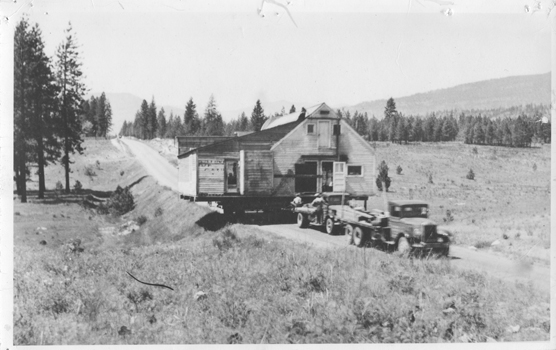Treasures of the Archives: Kettle Falls: Moving on Up

Link to photo: http://www.digitalarchives.wa.gov/Record/View/92F2AB61318ACA3B9E87FFDE0FD16482
This house moved slowly up the hill to avoid the flooding waters of Lake Roosevelt. In mid-1941 the waters of the Columbia River began to rise behind the Grand Coulee Dam, covering the arid landscape with hundreds of feet of water. The filling of the reservoir behind the 550 foot Grand Coulee Dam forced every animal, plant, and human that called the river banks home to relocate and change their way of life.
The Works Progress Administration, a New Deal Agency designed to put men to work, was responsible for clearing everything, including houses, railroad tracks, and trees, below an elevation of 1310 feet. Within the area that needed to be cleared there were about twenty towns and cities of varying sizes. One of the largest of those cities was Kettle Falls. The city was situated near a native fishing site that once was one of the largest salmon fisheries on the Columbia River. The WPA informed residents of the city that they would be forced to move so the residents came up with a plan.
In the mid 1930s the residents of Kettle Falls began eyeing a new location for their city. According to the National Park Service, they were “unable to obtain land adjacent to St. Paul's mission, their first choice for a new town site.” Instead “Kettle Falls residents annexed the nearby higher town of Meyers Falls and a strip of land along the state highway connecting the two communities.” Once Meyers Falls was annexed the residents voted to change the name to Kettle Falls. The residents began moving their homes and businesses up the hill to newly annexed areas. Walking through Kettle Falls today you would see many houses and buildings that were moved in the 1930s from the town site at the river’s edge.
Explore more photographs from the flooded towns before the lake in the Crossroads of the Columbia Collection at the Washington State Digital Archives.

